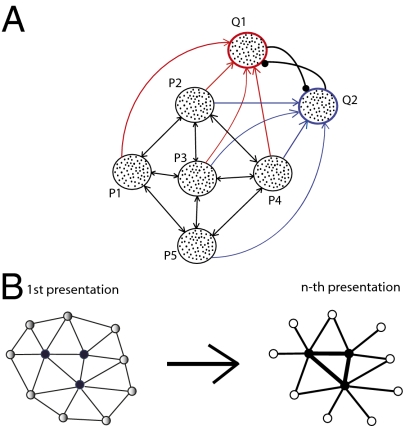Fig. 1.
(A) Network model consisted of five populations of spiking neurons (P1–P5). Each population contained 100 excitatory and 25 inhibitory neurons. Recurrent excitatory connections between excitatory neurons in different populations were adjustable. Inhibitory interneurons received fixed excitatory connections from excitatory neurons from all five excitatory populations and sent inhibitory projections onto the neurons of the same population. A stimulus applied to the spiking neural network model led to representation sharpening with repetition, as observed in the rate model. After the first presentation, the strengths of connections between neurons in populations P1 and P2 increased but those between the other populations decreased (Lower Right). (B) Schematic illustration of representation sharpening. Initial presentation of a stimulus activated a pattern of units in early visual areas (Left). The units in the pattern were activated to varying degrees. Darker filled circles indicate higher activity levels. After several stimulus repetitions (Right), only the most active units continued to respond and weakly responding units were eliminated from the representation of the stimulus. Strengths of connections (indicated by thickness of lines connecting units) between strongly activated units were strengthened, and connections to weakly active units were eliminated.

